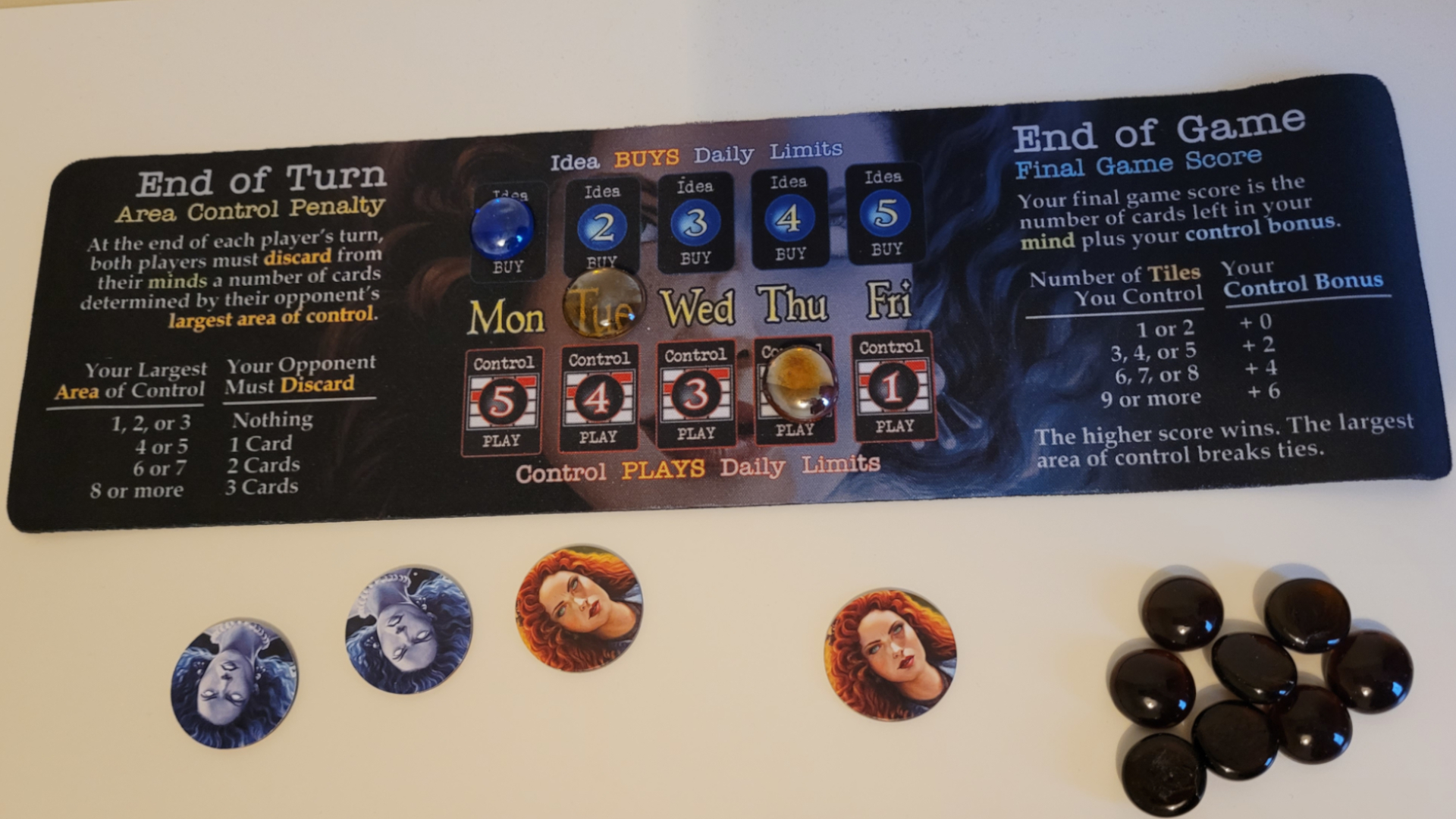GamesRadar+ Verdict
As with any good ghost story, The Mirroring of Mary King takes the familiar and turns it into something strange. This is a thoughtful, evocative experience... but also a fun puzzle to solve.
Pros
- +
Unique theme and unusual gameplay that’s straightforward to learn
- +
Great art, including very evocative central portrait
- +
Poses interesting questions about identity
Cons
- -
Can feel more like a tactical tug of war than a strategic battle
- -
Appears to have more meaningful decision points than it really does
Why you can trust GamesRadar+
The Mirroring of Mary King probably won't be on your radar, and that isn't altogether surprising; the board games industry is full of enthusiastic designers who beaver away making interesting things without much regard for market success. But there are few who are as consistently interesting as Jim Felli. From conniving cannibals to a game about two-mile-tall, landscape-eating frogs, his games are full of bizarre themes and concepts.
His latest, The Mirroring of Mary King, goes for the relatively tame concept of fighting off ghostly possession. But as ever, there are plenty of frights in the execution.
What is it, and how does it work?

- Players: 2
- Complexity: Moderate
- Lasts: 20+ mins
- Ages: 13+
One player takes the role of Mary King, a modern-day Scottish woman who unwisely visits the resting place of an ancestor - whose spirit is controlled by the second player. Mary is represented by twelve double-sided tiles that make up her portrait, which flip from her mortal self to the possessing spirit. The aim is to have as many contiguous tiles flipped to 'your' side as possible at the end of each of the game’s five rounds. If, at any point, one side controls them all, they win an instant victory.
Among the rules for setting up is an apparently trivial yet telling instruction: rather than sit opposite, players must sit alongside each other, reinforcing the sense that they’re in a struggle for the same consciousness. This kind of detail is typical of Felli, and it works. Sitting together adds a peculiar sense of camaraderie to the competition.
Each player also has a deck of cards called their "mind". There are two kinds of cards: control cards flip over the indicated tiles among the 12 making up Mary’s portrait, regardless of what side they’re currently on. Power cards, meanwhile, give you a choice of two special one-off effects. "Forget", for example, can either be played to nullify an opponent’s card or to remove a card from their mind and from their hand. The two decks are slightly different, making this an asymmetrical game.
Sitting together adds a peculiar sense of camaraderie to the competition
Some cards, however, don’t end up in your mind but in little piles next to the portrait. These are referred to as "ideas". The top card of each idea stack is face up, and you can buy it by removing a card from your mind. Crucially, you can buy your opponent’s ideas, giving you an opportunity to double up on a card effect or access to the unique cards in the other deck. As the five turns of the game progress, you can play fewer control cards from your hand and buy increasing numbers of cards to compensate.
At the end of each turn, your opponent has to discard a number of cards from their mind depending on how many contiguous tiles are flipped to your side. Presuming no one wins an instant victory, the winner is determined at game end by the number of tiles you control and the number of cards left in your mind.
Gameplay - is it any good?

When you first start playing The Mirroring of Mary King, the focus is very much on the tactical back-and-forth of control cards to flip key tiles in Mary’s portrait. It’s a fun puzzle because control cards can be oriented either way up, and you’ll often have to sacrifice one or two tiles you already control as part of the overall pattern. Weighing up the possibilities, especially the opportunities afforded by buying ideas, and trying to get the largest area of connected tiles you can, is a challenge that doesn’t get old.
Your reward for claiming a run of tiles is seeing your opponent burning cards from their memory. And after your first play, you’ll understand that there’s a second, more strategic game going on here as well: the management of your card pile. It’s very tempting to throw away unknown cards from your mind in exchange for known cards from idea piles, but it’s also a good way to run your deck down very fast.
Terse, scrappy, random rounds are well suited to a game that’s quite easy to learn and fast to play
This is where the power cards come into play. Most of them fiddle with the pace of cards flowing out of your - or your opponent’s - memory in some way. Take ghost Mary’s card "cunning", for example. It lets you take three random cards from your discard pile and choose one to put into your hand and one into your mind. Or it lets you swap cards from your hand for ones in your memory or ideas. The latter is a powerful instant impact on the game, especially if you have a weak draw. But the former buys you an advantage in the long game. It’s up to you to judge the game state and decide which is better.
Most power cards also bear an icon that affects what you do after you’ve played it. For most, you put it on the bottom of your discard pile, making it harder to retrieve with other card effects. Some, though, allow you to recall them, which means discarding a card from your mind and then reshuffling that card into it. These are another devil’s snare for players, because you don’t know what you’re paying to recall the card and you don’t know when you’ll get your card again. But many of them bear powerful effects that can flip the tile state or your opponent’s mind.

While there’s a lot to consider here each turn, there’s also a lot of uncertainty. You can’t count all the cards and you can’t predict the future, so some of your decisions are absolute shots in the dark that may, like Mary’s ghost, come back to haunt you. It’s more of a tactical game than a strategic one, but its tile-flipping exchanges keep up an engaging and exciting tempo, as Mary’s fate hangs in the balance between you. The way her portrait literally shows her personal struggles as the tiles flip back and forth is a strangely affecting experience. And besides, terse, scrappy, random rounds are well suited to a game that’s quite easy to learn and fast to play.
Should you buy The Mirroring of Mary King?
Taken individually, the mechanical parts that make up The Mirroring of Mary King are things that we’ve seen before from board games for 2 players: tile-flipping, hand management, and pattern matching. But like in any good ghost story, this game takes the familiar and turns them into something strange and new. They’re not just adjuncts in a game about zones of control, but coin tosses that ask us questions about duality, about ancestry, and about who we are. There are few games that leave the players with any questions at all, and a few sacrifices on the strategy front are a worthwhile loss to enjoy something so unusual and thought-provoking.
How we tested The Mirroring of Mary King
I played The Mirroring of Mary King multiple times to get a sense for its mechanics and their longevity, including how easy it is to get into and in comparison to Jim Felli's previous work.
Matt is a freelance writer specialising in board games and tabletop. With over a decade of reviews under his belt, he has racked up credits including IGN, Dicebreaker, T3, and The Guardian.




